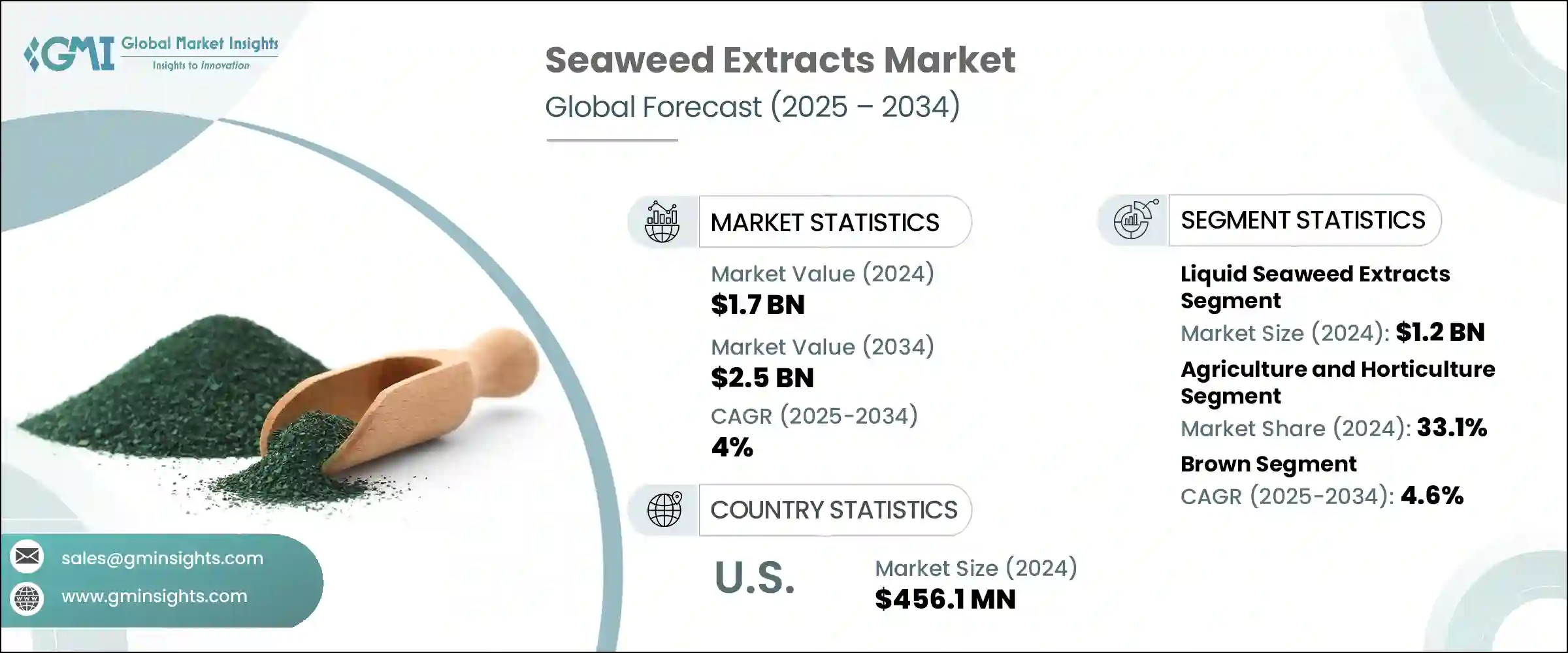
|
시장보고서
상품코드
1773365
해조 추출물 시장 기회와 촉진요인, 업계 동향 분석 및 예측(2025-2034년)Seaweed Extracts Market Opportunity, Growth Drivers, Industry Trend Analysis, and Forecast 2025 - 2034 |
||||||
세계의 해조 추출물 시장은 2024년에는 17억 달러로 평가되었고 CAGR 4%를 나타내 2034년에는 25억 달러에 이를 것으로 추정되고 있습니다. 또한 가공식품의 천연증점제로서의 역할을 하거나 화장품에 항산화특성을 부여하는 등 다기능 이점이 인정되고 있습니다.

해조 추출물은 식물의 바이오스티뮬란트나 천연의 토양 개량제로서, 양분의 흡수나 토양의 통기성을 개선합니다. 간단하고, 대규모 농업이나 소규모 원예 작업에 최적입니다.효과적인 토양 개량제로서 기능할 뿐만 아니라, 칼륨, 마그네슘, 철 등의 필수 미량 미네랄을 공급해, 식물의 발육이나 스트레스 내성에 중요한 역할을 합니다.
| 시장 범위 | |
|---|---|
| 시작 연도 | 2024년 |
| 예측 연도 | 2025-2034년 |
| 시작 금액 | 17억 달러 |
| 예측 금액 | 25억 달러 |
| CAGR | 4% |
해조 추출물 시장의 액체 제제 부문은 2024년에 12억 달러를 창출했습니다. 선호되는 것은 균일한 점도, 준비 시간 단축, 표준 관개 시스템과의 적합성에 의한 것입니다.
농업·원예 분야는 2024년에 33.1%의 점유율을 차지했고 2034년까지 연평균 복합 성장률(CAGR) 4.3%를 나타낼 것으로 예측됩니다. 화합물은 합성 첨가물의 클린 라벨 대체품으로 강한 수요를 획득하고 있습니다.
2024년 미국의 해조 추출물 시장 규모는 4억 5,610만 달러였습니다. 이 지역의 성장은 농업, 식품, 화장품, 의약품의 각 분야에 있어서 수요가 견인하고 있습니다. 한편, 식품에 있어서의 클린 라벨 원료로의 시프트와 자연 화장품 증가는 해조 베이스의 증점제, 안정제, 항산화제나 항염증제와 같은 스킨케어 유익 물질의 사용을 뒷받침하고 있습니다.
해조 추출물 주요 시장 진출기업은 Algaia SA, DuPont de Nemours, Inc. Roullier Group, Gelymar SA, Cargill, Inc. 등이 있습니다. 신흥국 시장은 특정 최종 시장에 맞는 고순도의 표준화 추출물을 개발하기 위해 연구 개발 투자를 강화하고 있습니다. 유기농 기준을 충족하는 인증을 취득하는 것으로, 추적 가능성를 강화하고 있습니다. 또한, 생산 능력을 확대해, 주요한 해조 양식 지역의 근처에 시설을 설치하는 것으로, 공급의 신뢰성과 코스트 효율을 확보하고 있습니다.
목차
제1장 조사 방법과 범위
제2장 주요 요약
제3장 업계 인사이트
- 생태계 분석
- 공급자의 상황
- 이익률
- 각 단계에서의 부가가치
- 밸류체인에 영향을 주는 요인
- 파괴적 혁신
- 업계에 미치는 영향요인
- 성장 촉진요인
- 업계의 잠재적 위험 및 과제
- 시장 기회
- 성장 가능성 분석
- 규제 상황
- 북미
- 유럽
- 아시아태평양
- 라틴아메리카
- 중동 및 아프리카
- Porter's Five Forces 분석
- PESTEL 분석
- 가격 동향
- 지역별
- 제품별
- 향후 시장 동향
- 기술과 혁신의 상황
- 현재의 기술 동향
- 신흥기술
- 특허 상황
- 무역 통계(HS코드)(참고 : 무역 통계는 주요 국가에서만 제공됨)
- 주요 수입국
- 주요 수출국
- 지속가능성과 환경 측면
- 지속가능한 관행
- 폐기물 감축 전략
- 생산에 있어서의 에너지 효율
- 환경 친화적인 노력
제4장 경쟁 구도
- 서론
- 기업의 시장 점유율 분석
- 지역별
- 북미
- 유럽
- 아시아태평양
- 라틴아메리카
- 중동 및 아프리카
- 지역별
- 기업 매트릭스 분석
- 주요 시장 기업의 경쟁 분석
- 경쟁 포지셔닝 매트릭스
- 주요 발전
- 합병과 인수
- 파트너십 및 협업
- 신제품 발매
- 확장 계획
제5장 시장 추계·예측 : 제품별(2021-2034년)
- 주요 동향
- 액체 해조 추출물
- 분말 해조 추출물
- 플레이크 및 과립
- 기타 형식
제6장 시장 추계·예측 : 용도별(2021-2034년)
- 주요 동향
- 농업 및 원예
- 식품 및 음료
- 동물 사료
- 화장품 및 퍼스널케어
- 의약품 및 영양보조식품
- 기타 산업용도
제7장 시장 추계·예측 : 해조 유형별(2021-2034년)
- 주요 동향
- 갈조류
- 붉은 해조
- 녹색 해조
제8장 시장 추계·예측 : 지역별(2021-2034년)
- 주요 동향
- 북미
- 미국
- 캐나다
- 유럽
- 독일
- 영국
- 프랑스
- 이탈리아
- 스페인
- 기타 유럽
- 아시아태평양
- 중국
- 인도
- 일본
- 호주
- 한국
- 기타 아시아태평양
- 라틴아메리카
- 브라질
- 멕시코
- 아르헨티나
- 기타 라틴아메리카
- 중동 및 아프리카
- 사우디아라비아
- 남아프리카
- 아랍에미리트(UAE)
- 기타 중동 및 아프리카
제9장 기업 프로파일
- Acadian Seaplants Limited
- Algaia SA
- Cargill, Inc.
- CP Kelco(JM Huber Corporation)
- DuPont de Nemours, Inc.
- Gelymar SA
- Qingdao Gather Great Ocean Algae Industry Group
- Roullier Group
- Seasol International
The Global Seaweed Extracts Market was valued at USD 1.7 billion in 2024 and is estimated to grow at a CAGR of 4% to reach USD 2.5 billion by 2034. This growth is driven by a surge in demand for organic, sustainable, and bio-based products across sectors such as personal care, food, pharmaceuticals, and agriculture. These marine-derived concentrates, rich in trace elements and natural growth hormones, have gained recognition for their multifunctional benefits-from enhancing plant resilience to serving as natural thickeners in processed foods and offering antioxidant properties in cosmetics. As consumers increasingly seek clean-label and eco-conscious products, seaweed extracts have attracted attention for their versatility and positive sustainability profile, positioning them as a valuable ingredient in natural formulations and farming inputs.

Seaweed extracts serve as plant biostimulants and natural soil enhancers, improving nutrient uptake and soil aeration. Available in user-friendly forms such as soluble powders and flakes, seaweed extracts provide versatile organic solutions that integrate seamlessly with traditional and organic farming practices. These formats are easy to handle, store, and mix, making them ideal for large-scale agricultural use as well as smaller horticultural operations. In addition to acting as effective soil conditioners, they supply essential trace minerals like potassium, magnesium, and iron, which play a vital role in plant development and stress tolerance. Their natural chelating properties enhance the bioavailability of nutrients in the soil, improving uptake efficiency and overall plant health.
| Market Scope | |
|---|---|
| Start Year | 2024 |
| Forecast Year | 2025-2034 |
| Start Value | $1.7 Billion |
| Forecast Value | $2.5 Billion |
| CAGR | 4% |
Liquid formulations segment in the seaweed extracts market generated USD 1.2 billion in 2024. Their ease of application and rapid absorption have made them a preferred option across a range of agricultural practices, particularly for foliar spraying and soil enhancement. Farmers favor these formulations due to their uniform consistency, reduced preparation time, and compatibility with standard irrigation systems. The effectiveness of liquid seaweed in improving crop resilience, nutrient uptake, and yield further drives its widespread use, especially in precision farming and organic cultivation methods.
The agriculture and horticulture segment accounted for a 33.1% share in 2024 and is projected to grow at a CAGR of 4.3% through 2034. As growers increasingly shift toward sustainable inputs, seaweed extracts have gained traction as natural biostimulants and soil conditioners. Meanwhile, in the food and beverage sector, seaweed-derived compounds such as carrageenan and agar are experiencing strong demand as clean-label alternatives to synthetic additives. Their ability to deliver texture, viscosity, and shelf-life improvements in sauces, dairy substitutes, and ready-to-eat products reinforces their critical role in reformulated and plant-based offerings.
United States Seaweed Extracts Market generated USD 456.1 million in 2024. Growth in the region is driven by demand across agriculture, food, cosmetics, and pharmaceuticals. Increasing awareness around organic farming and stress resilience in crops has fueled adoption in biostimulant markets. Meanwhile, the shift toward clean-label ingredients in food and the rise in natural cosmetics have boosted the use of seaweed-based thickeners, stabilizers, and skincare beneficials like antioxidants and anti-inflammatories.
Major players operating in the Seaweed Extracts Market include Algaia S.A., DuPont de Nemours, Inc., Roullier Group, Gelymar S.A., and Cargill, Inc. Leading firms are boosting their R&D investments to develop high-purity, standardized extracts tailored for specific end-markets. They're forming partnerships with agricultural cooperatives, food manufacturers, and skincare brands to integrate seaweed extracts into new bio- and eco-based products. Companies are also enhancing traceability by implementing sustainable sourcing programs and obtaining certifications to meet clean-label and organic standards. In addition, expanding production capacity and establishing facilities near major seaweed farming regions ensures supply reliability and cost efficiency. Firms leverage strategic acquisitions and joint ventures to diversify product portfolios-combining algal biostimulants with complementary inputs.
Table of Contents
Chapter 1 Methodology and Scope
- 1.1 Market scope and definition
- 1.2 Research design
- 1.2.1 Research approach
- 1.2.2 Data collection methods
- 1.3 Data mining sources
- 1.3.1 Global
- 1.3.2 Regional/country
- 1.4 Base estimates and calculations
- 1.4.1 Base year calculation
- 1.4.2 Key trends for market estimation
- 1.5 Primary research and validation
- 1.5.1 Primary sources
- 1.6 Forecast model
- 1.7 Research assumptions and limitations
Chapter 2 Executive Summary
- 2.1 Industry 3600 synopsis
- 2.2 Key market trends
- 2.2.1 Regional
- 2.2.2 Product
- 2.2.3 Application
- 2.2.4 Seaweed source
- 2.3 TAM analysis, 2025-2034
- 2.4 Cxo perspectives: strategic imperatives
- 2.4.1 Executive decision points
- 2.4.2 Critical success factors
- 2.5 Future outlook and strategic recommendations
Chapter 3 Industry Insights
- 3.1 Industry ecosystem analysis
- 3.1.1 Supplier landscape
- 3.1.2 Profit margin
- 3.1.3 Value addition at each stage
- 3.1.4 Factor affecting the value chain
- 3.1.5 Disruptions
- 3.2 Industry impact forces
- 3.2.1 Growth drivers
- 3.2.2 Industry pitfalls and challenges
- 3.2.3 Market opportunities
- 3.3 Growth potential analysis
- 3.4 Regulatory landscape
- 3.4.1 North America
- 3.4.2 Europe
- 3.4.3 Asia Pacific
- 3.4.4 Latin America
- 3.4.5 Middle East & Africa
- 3.5 Porter's analysis
- 3.6 Pestel analysis
- 3.6.1 Technology and innovation landscape
- 3.6.2 Current technological trends
- 3.6.3 Emerging technologies
- 3.7 Price trends
- 3.7.1 By region
- 3.7.2 By product
- 3.8 Future market trends
- 3.9 Technology and innovation landscape
- 3.9.1 Current technological trends
- 3.9.2 Emerging technologies
- 3.10 Patent landscape
- 3.11 Trade statistics (HS code) (note: the trade statistics will be provided for key countries only)
- 3.11.1 Major importing countries
- 3.11.2 Major exporting countries
- 3.12 Sustainability and environmental aspects
- 3.12.1 Sustainable practices
- 3.12.2 Waste reduction strategies
- 3.12.3 Energy efficiency in production
- 3.12.4 Eco-friendly initiatives
Chapter 4 Competitive landscape, 2024
- 4.1 Introduction
- 4.2 Company market share analysis
- 4.2.1 By Region
- 4.2.1.1 North America
- 4.2.1.2 Europe
- 4.2.1.3 Asia Pacific
- 4.2.1.4 LATAM
- 4.2.1.5 MEA
- 4.2.1 By Region
- 4.3 Company matrix analysis
- 4.4 Competitive analysis of major market players
- 4.5 Competitive positioning matrix
- 4.6 Key developments
- 4.6.1 Mergers & acquisitions
- 4.6.2 Partnerships & collaborations
- 4.6.3 New product launches
- 4.6.4 Expansion plans
Chapter 5 Market Estimates and Forecast, By Product, 2021 - 2034 (USD Million) (Kilo Tons)
- 5.1 Key trends
- 5.2 Liquid seaweed extracts
- 5.3 Powdered seaweed extracts
- 5.4 Flakes and granules
- 5.5 Other forms
Chapter 6 Market Estimates and Forecast, By Application 2021 - 2034 (USD Million) (Kilo Tons)
- 6.1 Key trends
- 6.2 Agriculture and horticulture
- 6.3 Food & beverages
- 6.4 Animal feed
- 6.5 Cosmetics & personal care
- 6.6 Pharmaceuticals & nutraceuticals
- 6.7 Other industrial uses
Chapter 7 Market Estimates and Forecast, By Seaweed Source, 2021 - 2034 (USD Million) (Kilo Tons)
- 7.1 Key trends
- 7.2 Brown seaweed
- 7.3 Red seaweed
- 7.4 Green seaweed
Chapter 8 Market Estimates and Forecast, By Region, 2021 - 2034 (USD Million) (Kilo Tons)
- 8.1 Key trends
- 8.2 North America
- 8.2.1 U.S.
- 8.2.2 Canada
- 8.3 Europe
- 8.3.1 Germany
- 8.3.2 UK
- 8.3.3 France
- 8.3.4 Italy
- 8.3.5 Spain
- 8.3.6 Rest of Europe
- 8.4 Asia Pacific
- 8.4.1 China
- 8.4.2 India
- 8.4.3 Japan
- 8.4.4 Australia
- 8.4.5 South Korea
- 8.4.6 Rest of Asia Pacific
- 8.5 Latin America
- 8.5.1 Brazil
- 8.5.2 Mexico
- 8.5.3 Argentina
- 8.5.4 Rest of Latin America
- 8.6 Middle East and Africa
- 8.6.1 Saudi Arabia
- 8.6.2 South Africa
- 8.6.3 UAE
- 8.6.4 Rest of MEA
Chapter 9 Company Profiles
- 9.1 Acadian Seaplants Limited
- 9.2 Algaia S.A.
- 9.3 Cargill, Inc.
- 9.4 CP Kelco (J.M. Huber Corporation)
- 9.5 DuPont de Nemours, Inc.
- 9.6 Gelymar S.A.
- 9.7 Qingdao Gather Great Ocean Algae Industry Group
- 9.8 Roullier Group
- 9.9 Seasol International













